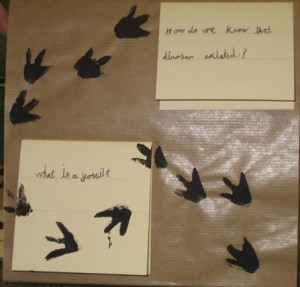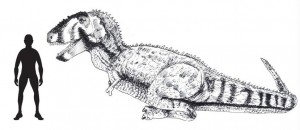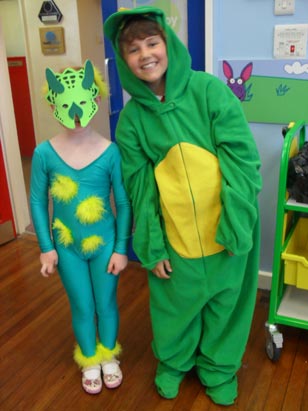Miss Allen’s Class Explore Dinosaur Footprints and Come Up with Fascinating Theories
One of the great things about palaeontology is that it is a very accessible science field. When looking for the Higgs Boson particle a Large Hadron Collider is required but with palaeontology, going for a walk in an area where fossils can be found and turning a few rocks over might lead to a discovery that changes the way that scientists view the world. Everything Dinosaur team members gave pupils a taste for palaeontology during a school visit which gave the children the chance to study some real dinosaur tracks.
For Miss Allen’s class of Year 5/6 pupils at Grange Moor Primary School (Wakefield, West Yorkshire), they got the chance to get to grips with a real palaeontology puzzle by studying a bizarre set of fossilised dinosaur tracks that had recently been discovered in the United States.
Dinosaur Tracks
Miss Allen’s Class 3 were given the opportunity to take part in some real palaeontology and to come up some scientific theories of their own when they were invited to try to work out what a set of dinosaur tracks made many millions of years ago might reveal about the behaviour of prehistoric animals.
Dinosaurs as a term topic can be help provide students with challenging assignments and the teachers and teaching assistants at Grange Moor Primary School certainly came up with a number of creative and imaginative lesson plans for the pupils to enjoy.
In this particular lesson, involving year 5/6 students at the school, a series of pictures and drawings were shown to the class. These illustrate a strange set of dinosaur tracks that were made next to a drying up lake by a dinosaur that lived during the Early Jurassic geological period.
The children were given a set of structured assignments to accomplish, using a worksheet and the scientific illustrations they were tasked with interpreting the fossil evidence and just like a real scientist, they had to come up with a theory to explain the strange foot prints and marks that had been preserved.
Pupils at Grange Moor Primary School Studying a Set of Dinosaur Footprints
Picture credit: Everything Dinosaur
The picture above shows a recreation of a dinosaur trackway.
Studying Dinosaur Footprints
The pupils had to work out the direction of travel and why scientists include scale bars when presenting scientific information. To conclude this exercise the children had to try to come up with a theory that might explain the strange tracks and markings preserved in the fossilised mud. Just like a real palaeontologist they had to evaluate the evidence and come with their own hypothesis as to what might have happened.
Just like in real palaeontology, there were lots of different theories put forward. Some of the children’s ideas are listed below:
Genevieve – she thought that more than one dinosaur had walked over the ground.
Olivia – suggested that a hunting dinosaur may have dropped its catch and this had been preserved in the dinosaur tracks.
Amelia and Kelsey – proposed that the shore of the lake may have been slippy and the dinosaur may have fallen over.
Matthew – stated that the tracks and strange marks preserved as fossils may show where a mother dinosaur dropped its baby whilst carrying it along the side of the lake.
The pupils came up with a number of fascinating ideas, all or which could be relevant as since no scientists were around 190 million years ago, it is difficult to say exactly what actually happened.
However, our theory is that a large, bipedal dinosaur had been to the lake to have a drink, it must have been a hot day so it decided to cool off by sitting in the mud for a short while to rest. As the animal sat down it left its impression of its “hands” and bottom in the mud.
The “handprints”, as far as we at Everything Dinosaur know, are the first trace fossils of a meat-eating dinosaur’s front limbs found to date. The resting position of the front limbs of this dinosaur can be calculated by looking at the fossilised marks in the mudstone and this is helping palaeontologists to understand more about how the “hands” of dinosaurs worked.
One Theory – A Dinosaur Takes a Rest on a Hot Day
Picture credit: Everything Dinosaur
Proposing Theories
The pupils came up with a variety of explanations, as well as learning about how scale measures are used in scientific drawings and calculating the actual size of the tracks. All useful in helping to familiarise the students with aspects of mathematics such as scale drawings, simple calculations and accurate measuring objects.
To learn more about Everything Dinosaur’s science outreach work: Contact Everything Dinosaur via Email.
Miss Allen even entered into the spirit of the dinosaur day by coming into the classroom dressed as a dinosaur. The pupils at Grange Moor Primary School are certainly very lucky to have such enthusiastic and hard working teachers and teaching assistants to encourage and motivate them.
Miss Allen and Amy as Dinosaurs
Picture credit: Grange Moor Primary School.
The picture above shows Miss Allen (Class 3 teacher) dressed up as a dinosaur. Alongside Miss Allen is Amy, a pupil at the school who, like a lot of her classmates came as a dinosaur for the special dinosaur day with Everything Dinosaur.
For dinosaur and prehistoric animal themed toys and games, visit: The Everything Dinosaur Website.





Thanks for the great post! Keep up the good work….